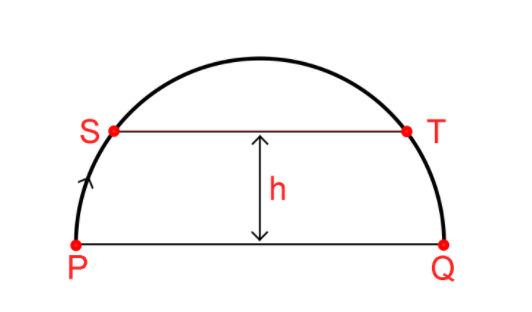
An oblique projectile projected from the ground takes time $4s$ to travel from $P$ to $Q$ while takes $2s$ to travel from $S$ to $T$. The height $h$ of level $ST$ from level $PQ$ is:

(A). $15m$
(B). $10m$
(C). $12.5m$
(D). $8.5m$

Answer
578.1k+ views
Hint: You can start by explaining projectiles. Then write the equation for the time of flight of a projectile and the equation for the maximum height i.e. \[t = \dfrac{{2u\sin \theta }}{g}\] for the motion of projectile from point $P$ to $Q$ and from $S$ to $T$ and calculate the value of \[u\sin \theta \] and \[u'\sin \theta \]. Then use the equation Maximum height \[ = \dfrac{{{u^2}{{\sin }^2}\theta }}{{2g}}\] and calculate the maximum height for the motion of projectile from point $P$ to $Q$ and from $S$ to $T$. Then find the difference between these two to reach the solution.
Complete step-by-step answer:
Projectiles are bodies that are launched with some initial velocity, reach a certain maximum height while covering a certain horizontal range. An example of projectiles is a ball thrown into the sky.
Given time of flight of a projectile for motion from point \[P\] to \[Q = 4\sec \] and for the motion from point \[S\] to \[T = 2\sec \] .
Let’s assume that the velocity of the projectile at the point \[P\] is \[u\] and the velocity of the projectile at the point \[S\] is \[u'\] .
We know that the equation for the time of flight of a projectile is
\[t = \dfrac{{2u\sin \theta }}{g}\]
So, for the motion of the projectile from point \[P\] to \[Q\] , we have
\[\dfrac{{2u\sin \theta }}{g} = 4\sec \]
\[u\sin \theta = \dfrac{{4g}}{2} = 2g\]
\[u\sin \theta = 20m/s\] (Taking \[g = 10m/{s^2}\] )
And, for the motion of the projectile from point \[S\] to \[T\] , we have
\[\dfrac{{2u'\sin \theta }}{g} = 2\]
\[ \Rightarrow u'\sin \theta = g = 10m/s\]
We also know that the equation for the maximum height is
Maximum height \[ = \dfrac{{{u^2}{{\sin }^2}\theta }}{{2g}}\]
So, the maximum height for the motion of the projectile from point \[P\] to \[Q\] is
\[H = \dfrac{{{u^2}{{\sin }^2}\theta }}{{2g}} = \dfrac{{400}}{{2 \times 10}}\]
\[ \Rightarrow H = 20m\]
And, the maximum height for the motion of the projectile from point \[S\] to \[T\] is
\[H' = \dfrac{{u{'^2}{{\sin }^2}\theta }}{{2g}} = \dfrac{{100}}{{2 \times 10}} = 5m\]
\[\therefore h = H - H' = 15m\]
Hence, option A is the correct choice.
Note: In the solution above, we have used the equations for the time of flight of projectile and the maximum height of the projectile, i.e. \[t = \dfrac{{2u\sin \theta }}{g}\] and Maximum height \[ = \dfrac{{{u^2}{{\sin }^2}\theta }}{{2g}}\] respectively. We could also use the equations for motion, but it would be an unnecessarily long method.
Complete step-by-step answer:
Projectiles are bodies that are launched with some initial velocity, reach a certain maximum height while covering a certain horizontal range. An example of projectiles is a ball thrown into the sky.
Given time of flight of a projectile for motion from point \[P\] to \[Q = 4\sec \] and for the motion from point \[S\] to \[T = 2\sec \] .
Let’s assume that the velocity of the projectile at the point \[P\] is \[u\] and the velocity of the projectile at the point \[S\] is \[u'\] .
We know that the equation for the time of flight of a projectile is
\[t = \dfrac{{2u\sin \theta }}{g}\]
So, for the motion of the projectile from point \[P\] to \[Q\] , we have
\[\dfrac{{2u\sin \theta }}{g} = 4\sec \]
\[u\sin \theta = \dfrac{{4g}}{2} = 2g\]
\[u\sin \theta = 20m/s\] (Taking \[g = 10m/{s^2}\] )
And, for the motion of the projectile from point \[S\] to \[T\] , we have
\[\dfrac{{2u'\sin \theta }}{g} = 2\]
\[ \Rightarrow u'\sin \theta = g = 10m/s\]
We also know that the equation for the maximum height is
Maximum height \[ = \dfrac{{{u^2}{{\sin }^2}\theta }}{{2g}}\]
So, the maximum height for the motion of the projectile from point \[P\] to \[Q\] is
\[H = \dfrac{{{u^2}{{\sin }^2}\theta }}{{2g}} = \dfrac{{400}}{{2 \times 10}}\]
\[ \Rightarrow H = 20m\]
And, the maximum height for the motion of the projectile from point \[S\] to \[T\] is
\[H' = \dfrac{{u{'^2}{{\sin }^2}\theta }}{{2g}} = \dfrac{{100}}{{2 \times 10}} = 5m\]
\[\therefore h = H - H' = 15m\]
Hence, option A is the correct choice.
Note: In the solution above, we have used the equations for the time of flight of projectile and the maximum height of the projectile, i.e. \[t = \dfrac{{2u\sin \theta }}{g}\] and Maximum height \[ = \dfrac{{{u^2}{{\sin }^2}\theta }}{{2g}}\] respectively. We could also use the equations for motion, but it would be an unnecessarily long method.
Recently Updated Pages
Why are manures considered better than fertilizers class 11 biology CBSE

Find the coordinates of the midpoint of the line segment class 11 maths CBSE

Distinguish between static friction limiting friction class 11 physics CBSE

The Chairman of the constituent Assembly was A Jawaharlal class 11 social science CBSE

The first National Commission on Labour NCL submitted class 11 social science CBSE

Number of all subshell of n + l 7 is A 4 B 5 C 6 D class 11 chemistry CBSE

Trending doubts
What is meant by exothermic and endothermic reactions class 11 chemistry CBSE

10 examples of friction in our daily life

One Metric ton is equal to kg A 10000 B 1000 C 100 class 11 physics CBSE

1 Quintal is equal to a 110 kg b 10 kg c 100kg d 1000 class 11 physics CBSE

Difference Between Prokaryotic Cells and Eukaryotic Cells

What are Quantum numbers Explain the quantum number class 11 chemistry CBSE




